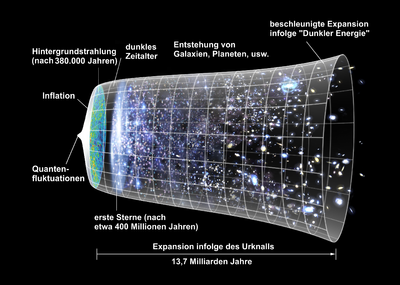Hubble's law
The Hubble constant 
The Hubble constant is measured by systematically recording the distance and apparent velocity of astronomical objects with respect to us. Since these must be distant astronomical objects, the measurements are complex and subject to large uncertainties compared to other natural constants. Measurements at the beginning of the 21st century yielded values between 


stages of the universe's evolution. The Hubble parameter indicates the instantaneous rate of expansion at any point in time.
Definition
The expansion of the universe is quantitatively described by the scale factor 

Where is 
The present value of the Hubble parameter is called the Hubble constant :
with the world age 
The ratio of the Hubble parameter to the present value is given as the expansion factor and can also be 
The time derivative of the Hubble parameter gives:
The Hubble flux denotes the rate at which spatial distances increase for the same world age and, by its very nature, cannot be observed directly because of the transit time of light:
In the local universe (i.e., over distances that are small compared to the radius of the observable universe), the Hubble constant is the constant of proportionality of the (approximately) linear relationship between the distances 

Where 
Often the product 

The precise relationship between cosmological redshift and distance is nonlinear and requires integration over the time course of the scale factor 
Hubble diagram
The plot of the redshift of astronomical objects against their distance from Earth is called a Hubble diagram. A uniformly expanding universe causes the objects in this diagram to be arranged along a straight line passing through the origin. The slope of this straight line is the Hubble constant.
The first Hubble diagram was published by Edwin Hubble in 1929. In this publication he reported a linear relationship between the distance of galaxies (extragalactic nebula) and their redshift. Determining the distance of a distant astronomical object without recourse to redshift is done from the brightness of standard candles. For this purpose, the image of the object must be so well resolved that no light from other objects distorts the measurement result. This becomes increasingly difficult with increasing distance. The data used in the first Hubble diagram extended to a distance of about 2 Mpc. Almost a century later, measurements up to about 700 Mpc are possible. This allows a much more reliable indication of the Hubble constant.
Questions and Answers
Q: What is Hubble's law?
A: Hubble's law, or the Hubble–Lemaître law, is an astronomical observation that all objects observed in deep space have a doppler shift-measured velocity relative to Earth and other interstellar bodies that is proportional to their distance from them. It also states that the space-time volume of the observable universe is expanding.
Q: Who first derived this law?
A: The law was first derived from General Relativity equations by Georges Lemaître in a 1927 article.
Q: Who confirmed its existence?
A: Edwin Hubble confirmed the existence of the law two years later and got a more accurate value for the constant that now bears his name.
Q: How was recession velocity measured?
A: Recession velocity was inferred from redshifts as measured earlier by Vesto Slipher in 1917 and related to velocity by him.
Q: What equation expresses this law?
A: The law is often expressed by the equation v = H0D, with H0 being the constant of proportionality (the Hubble constant) between proper distance D to a galaxy and its velocity v.
Q: What unit does H0 usually come in?
A: H0 is usually quoted in (km/s)/Mpc, which gives the speed in km/s of a galaxy 1 megaparsec (3.09×1019 km) away.
Q: What has been suggested about recent estimates of H0? A Recent 2011 estimate suggests that H0 = 73.8 ± 2.4 (km/s)/Mpc while an alternate approach using data from galactic clusters gave a value of 67 ± 3.2 (km/s)/Mpc with other methods giving figures between 70 and 72 (km/s)/Mpc . A recent 2016 method suggests that it may have been 66.53 km/s per megaparsec soon after expansion began, implying an increasing rate of expansion over time
Search within the encyclopedia






